The continuously changing load on the engine also results in a variable rate of heat generation. Thus to keep the engine working in the optimum temperature range, the rate of cooling must be varied.
A thermostat works to regulate engine temperature by controlling coolant flow to radiator.
At the temperature below set temperature, the main valve of thermostat is closed, preventing coolant flow to the radiator. At the set temperature, wax expansion opens the main valve, allowing coolant to partly flow through radiator. At higher temperatures, the main valve is fully open, circulating all coolant through the radiator.
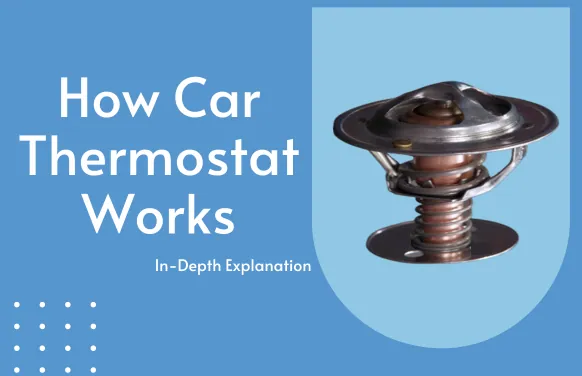
Keep reading to get details of how thermostat actually works to vary the cooling in engine.
Contents:
What is a Car thermostat?
The Car thermostat is an integral part of the engine cooling system, that controls the flow of coolant passing through the radiator to keep the engine within the optimum temperature range.
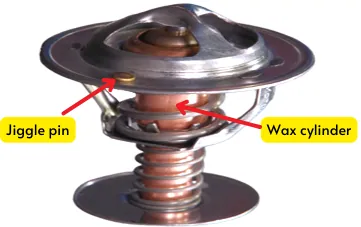
To maintain the engine temperature within the optimum range, it is necessary to vary the extent of cooling.
i.e. when we start the engine, it is essential for the engine to reach the optimum temperature quickly, thus in this situation, there is no need to use the radiator for heat rejection.
While at higher load, when the engine becomes superhot, it is necessary that maximum coolant should pass through the radiator for faster heat removal.
Therefore, it is necessary to vary the flow of coolant entering the radiator for cooling. The thermostat helps to control the flow of coolant passing through the radiator based on the temperature of the coolant.
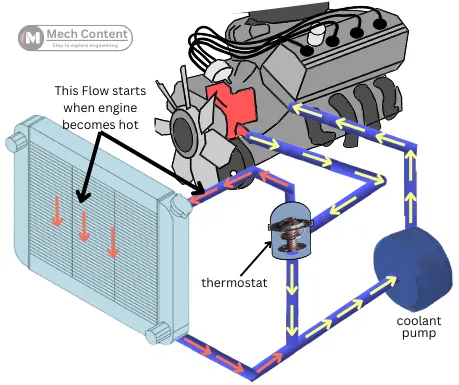
The temperature at which the thermostat starts to operate is known as the set temperature of the thermostat.
The thermostat is located inside the thermostat housing. The upper hose of the radiator is connected to the thermostat housing.
Without a thermostat or with a failing thermostat, the cooling system will not be able to handle the coolant flow through the radiator and it will become difficult to run the engine within the optimum temperature range.
Purpose/Function:
The purpose of the thermostat in the engine cooling system is as follows:-
1] To reach the optimum temperature faster:
At the optimum temperature, the engine burns fuel efficiently thus providing better fuel economy and lowered emissions. Also at optimum temperature, the engine has less wear rate.
Thus it is necessary that the engine should reach the optimum temperature range as fast as possible.
If the coolant is allowed to continuously circulate through the radiator, it will lose the heat from the engine to the atmosphere. Thus it will take longer to reach the optimum temperature.
For this purpose, it is necessary to stop the flow of coolant through the radiator for avoiding the loss of heat at the radiator.
The thermostat bypasses the flow of coolant through the radiator so that the engine can warm up faster.
2] Maintains the optimum temperature:
The thermostat controls the flow of coolant through the radiator. When the engine goes beyond the set temperature, the main valve of the thermostat becomes slightly open, thus the part of coolant coming from the engine is passed through the radiator to cool the coolant.
As much the temperature of the coolant goes beyond the set limit, the main valve of the thermostat opens more and more, boosting the flow of coolant toward the radiator to bring the engine temperature down within the optimal range.
As the temperature of the engine goes down, the thermostat lowers the flow of coolant through the radiator. In this way, the thermostat helps to keep the engine within its optimum range.
Car thermostat parts:
The thermostat consists of the following parts:
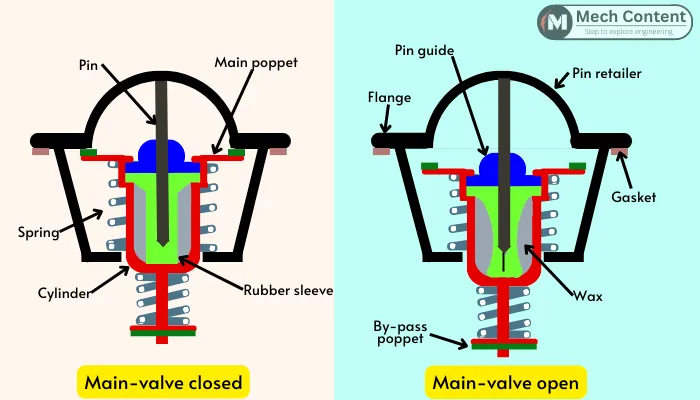
1] Wax Motor: The wax motor is a vital component of the thermostat as it is responsible for the actuation of the valves. The wax motor consists of the following components.
1a] Brass or copper cylinder: It is a metal container filled with wax. The outer surface of the wax cylinder comes in contact with the coolant and transfers the heat from the coolant to the wax.
The cylinder freely reciprocates within the support connected to the flange.
1b] Rubber sleeve: The rubber sleeve seals the wax inside the cylinder. When the wax expands, it causes the sleeve to squeeze, thus the pin is pushed outward.
1c] Piston or pin: The pin or piston is placed into the rubber sleeve and piston guide. The squeezing of the rubber sleeve causes the pin to move outside.
1d] Piston/ Pin guide: The pin guide is mounted above the rubber sleeve. It guides the movement of the piston/pin.
2] Main/primary valve: A flange and a main poppet form a primary valve. The main poppet is connected to the metal cylinder and thus moves along with the cylinder. The main valve controls the flow of coolant entering the radiator.
3] Pin retainer: A pin retainer holds the top end of the pin/piston. Thus during the expansion of wax, the pin/piston remains steady and the cylinder moves in a downward direction.
4] By-pass valve: By-pass valve controls the flow of coolant entering the by-pass hose. The poppet connected to the bottom of the metal cylinder forms a bypass valve.
5] Seal: The seal is mounted onto the flange of the thermostat, which prevents unwanted coolant flow across the main valve from the outside of the flange.
6] Spring: The spring helps to retain the main valve of the thermostat in a closed condition. When the temperature of the coolant goes down, the spring brings the cylinder to its original position.
7] Jiggle pin: Jiggle pin helps to remove the air trapped inside the coolant to the radiator.
How does a Car thermostat work?

Based on the temperature of the coolant, the working of the thermostat can be explained as follows:-
A] Below set temperature:
When the coolant temperature is below the set temperature (Fig. A) of the thermostat, (Due to the spring force) the main valve remains in a closed position and the bypass valve remains in an open condition.
As the main valve is closed, no amount of coolant is allowed to pass through the radiator.
B] Above set temperature:
When the temperature of the coolant reaches the set temperature of the thermostat (Fig. B), the wax inside the cylinder starts to melt and undergoes expansion. Thus it forces the rubber sleeve to pinch the pin in an outward direction.
As the pin moves outward, due to the reaction force, the cylinder is pushed in a downward direction.
As the poppet of the main valve is connected to the wax cylinder, the poppet moves in a downward direction to open the main valve.
The poppet of the by-pass valve is connected at the bottom of the cylinder, thus it moves along with the wax cylinder to cover the opening of the bypass valve.
At this condition, some amount of coolant flows through the main valve to the radiator.
C] At higher temperature:
When the engine is running at a higher temperature (Fig. C), the pin reaches its extreme position, thus it fully opens the main valve and completely closes the bypass valve.
Thus the total mass of fluid is circulated through the radiator.
Types of Car thermostats:
Following are the types of thermostats used in automobiles:-
A] Wax thermostat:
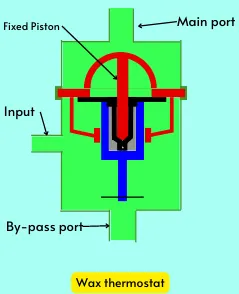
The wax thermostats are controlled on the basis of coolant temperature. Here the coolant flows over a wax cylinder, thus when the coolant temperature goes beyond the set temperature, it melts the wax inside the cylinder to actuate the valves.
B] Electronically controlled thermostat:
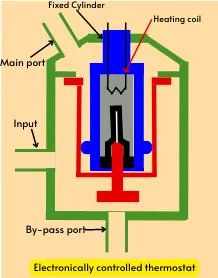
This type of thermostat uses a heater coil to melt the wax. The heater coil is placed inside the wax container.
The voltage given to the heater is controlled by the ECU. This makes the opening of the thermostat independent of the coolant temperature.
In the case of wax thermostats, when the load on the engine increases, it becomes hotter, and then it raises the coolant temperature. Afterward, the wax undergoes expansion and operates the valves. This causes thermostat valves to be activated late.
In the case of an electrically heated thermostat, when the load on the engine increases, the ECU sends the current to the heater coil.
Thus the wax expands and actuates the valve to raise the flow through the radiator. Therefore in this thermostat, the cooling process starts before raising the coolant temperature.
Hence this thermostat is faster than the normal wax thermostat and operated as per the speed and load on the engine.
FAQs:
-
What is the significance of the car thermostat?
The thermostat helps in achieving and maintaining the engine’s optimum temperature.
-
When does an automobile thermostat open?
As soon as the temperature of the coolant reaches the set limit of the thermostat, the main valve of the thermostat starts to open.
-
Can we run a car without a thermostat?
Running a car without a thermostat causes the engine to operate below the optimum temperature. Thus it can lower the fuel economy and also increases the rate of wear of engine components.